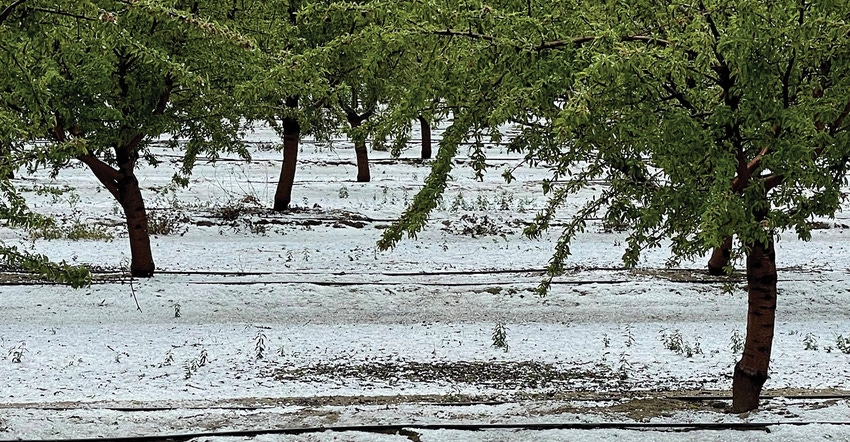
When your top crop in Fresno County is almonds, worth close to a billion dollars annually — and it’s bloom/bud season — sudden changes in weather conditions become a major factor in determining what kind of crop you’ll end up with.
That’s why unexpected March hailstorms in Fresno County set off alarm bells. While the hail was described as large and deep, it was also described as somewhat soft, almost like snow and although damage on undeveloped crops can go unnoticed for weeks, there was some noticeable damage to leaves and tree fruit.
In its March Growers Market Update, Meridian Growers cited another record month for almond shipments with the expectation that “the industry should show record shipments as the norm for the foreseeable future.” To which Jim Zion added: “Although the severity of the damage is currently unknown, California experienced severe hailstorms, much larger than typical, which will have a negative effect on the developing crop.”
The season had already gotten started when the rain-with-ice-pellets showed up. A Blue Diamond Almond Bloom Report by Vice President Mel Machado had noted the state’s weather, generally dry during the winter months, changed in late January with significant rain reported in much of the Central Valley and Northern San Joaquin Valley.
“Older, low-producing orchards had been removed with land prepped and new trees planted. Crews have been pruning and training trees and shredders grinding resulting brush. Beekeepers began delivering hives although a lack of rainfall has delayed germination of cover crops, limiting the amount of pre-bloom forage for bees to feed on," he wrote.
Young nut trees affected
Dwayne Cardoza, an organic raisin grape and tree nut farmer on 300-acres in Easton in Fresno County got hit by the storm. "We had hail activity with some damage reported in the hardest hit areas,” he said, “but what hurt worse was a frost a couple of days after the hail that brought on some fiddling around the edges of some of the buds that had already pushed out. It’s still early to really tell the extent of damage, but there were some young nuts on the ground as a result. We’re just keeping our fingers crossed.”
Ryan Jacobsen heads up the Fresno County Farm Bureau, one of 53 such farm bureaus in the state representing 4,000 family members in the Fresno region. “We have a great diversity here, somewhere in the neighborhood of 350 different crops and commodities with almonds being our No. 1, and so weather in the San Joaquin Valley is one of the most significant threats we face. Something like a hailstorm right after crop set can be devastating.
“The March hailstorm caused some havoc from north of Madera County down through parts of Kern County as it swept through,” he said. “Where I live and farm, my neighbors claim not to have seen a hailstorm like this in many decades. The hail, although it was brief, was up to dime size, although it wasn’t as rock-hard as hail sometimes gets. Nevertheless, some places got littered with that dime-sized hail that left a white blanket that lay on the ground for a while because of the colder weather that accompanied the storm and threatened freeze damage."
In Jacobsen’s case, the weather arrived post-bloom with crop set and green growth already weighing trees down. “These trees will undergo an actual shed in May and June as they kind of auto-correct themselves to balance the load, so if there was actual damage, the tree will try to take care of that naturally. With the ground covered in white, there is a likelihood there will be some damage. But with the trees self-correcting through their natural shed, we may not have experienced too much damage from that particular storm.”
For more news on tree nuts as reported by growers and farm advisors, subscribe to the Tree Nut Farm Press e-newsletter.
About the Author(s)
You May Also Like




